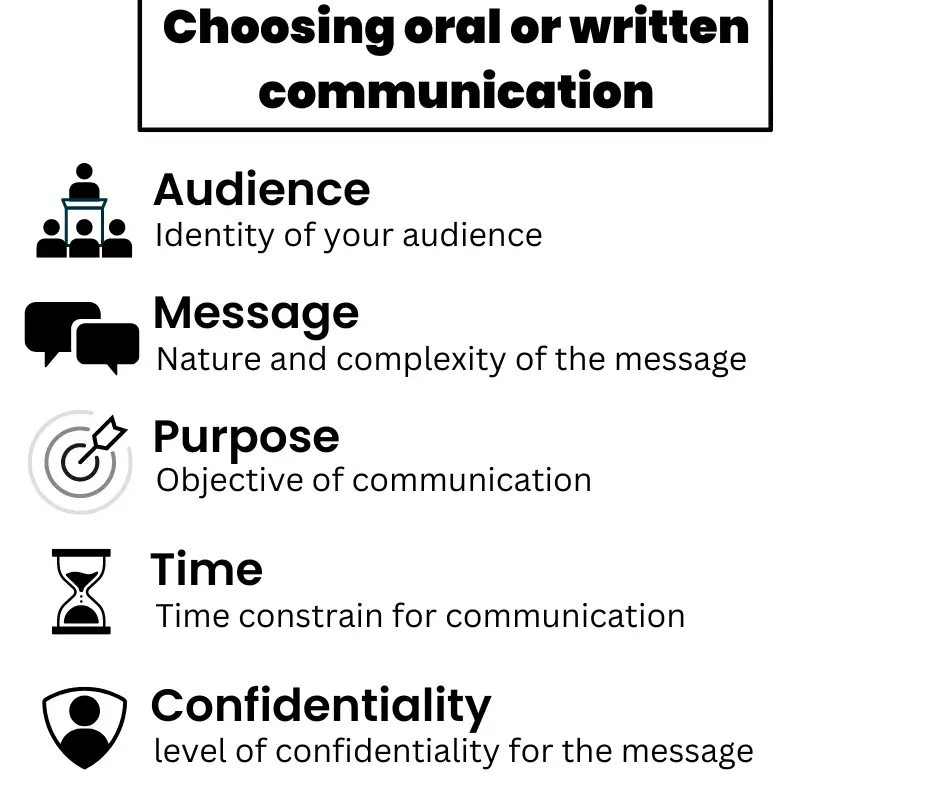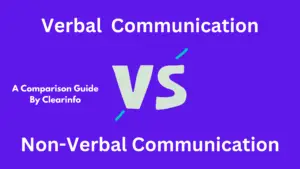In business and everyday life, communication is key. But when is it best to speak face-to-face, and when is it better to put things in writing? This blog post explores the differences between oral and written communication and offers insights into when each method is most effective.
Explanation of oral and written communication
The act of using spoken words to transmit messages or information is known as oral communication. This type of communication can take place in various forms such as face-to-face interactions, telephone conversations, and video or audio recordings.
Oral communication involves not just the words being spoken, but also the tone, pitch, and other nonverbal cues such as facial expressions, body language, and gestures. These features of oral communication can impact the effectiveness of the communication and its interpretation.
Moreover, oral communication can be formal, such as a business presentation or a speech, or informal, such as a conversation between friends.
Written communication, on the other hand, involves conveying information through written words. There are several forms in which it can be presented, such as emails, letters, reports, memos, text messages, social media posts, and other similar methods.
Written communication allows for a more precise and structured expression of ideas, as the writer has the opportunity to carefully choose their words and arrange them in a clear and organized manner.
Unlike oral communication, written communication does not involve nonverbal cues, and therefore relies solely on the words themselves to convey meaning.
Importance of understanding the differences between oral and written communication
Here are five key points on the importance of understanding the differences between oral and written communication:
1. Clarity: Understanding the differences between oral and written communication can help ensure that the intended message is conveyed accurately and clearly.
2. Tone and nonverbal cues: Oral communication involves tone, pitch, and nonverbal cues, while written communication relies solely on the words themselves. Knowing these differences can help avoid misunderstandings.
3. Audience: Different audiences may have different preferences for oral or written communication. Understanding their preferences can help tailor the message for maximum effectiveness.
4. Formality: Compared to written communication, oral communication tends to be less formal in nature. It is important to recognize the appropriate level of formality required for effective communication to ensure that the intended message is accurately conveyed.
5. Legal implications: In some cases, written communication may be legally binding, while oral communication may not be. Understanding these differences is important for legal and professional contexts.
A brief overview of oral vs written communication
Aspect of comparision | Oral Communication | Written Communication |
Feedback | Immediate | Delayed |
Channel | Spoken | Written |
Cues | Nonverbal cues such as tone, pitch, body language, and facial expressions | No nonverbal cues |
Structure | Can be less structured | More structured |
Editing | Limited opportunity for editing | Can be edited and revised |
Audience | Direct interaction with audience | Can reach a wider audience |
Formality | More informal | More formal |
Tone | Tone can vary depending on the situation and context | Tone can be more controlled and deliberate |
Time | Can be faster and more efficient for simple messages | Can take longer to compose and convey messages |
Clarity | Can be subject to interpretation and misunderstandings | Can be more precise and unambiguous |
Memory | Relies on memory | Can be referred to multiple times |
Engagement | Can be more engaging and interactive | Can be less engaging and interactive |
Preparation | Requires less preparation time | Requires more preparation time |
Impression | Impression is based on personal interaction | Impression is based on the quality of writing |
Convenience | Can be conducted anytime and anywhere | Requires a medium such as paper or computer |
Context | Context of oral communication can be more important | Written communication, can be more context-independent |
Interruptions | Oral communication can be interrupted by external factors. | There is no external interruption in written communication |
Accessibility | Oral communication, may not be accessible to people with hearing or speech impairments | Written communication can be more accessible |
Permanence | Oral communication, on the other hand, is more transient and ephemeral | Written communication can be more permanent |
Emotion | Can convey emotions through tone and nonverbal cues | Can convey emotions through word choice and sentence structure |
20 Key differences between oral and written communication
Communication may take many forms, but two of the most common are oral and written communication. Both forms of communication have their own strengths and weaknesses, and understanding these differences can help you choose the right approach for a given situation.
1. Feedback: In oral communication, feedback is immediate as the speaker can see and hear the reaction of the audience in real-time. This allows the speaker to adjust their message, tone, and style to better engage the audience. In contrast, written communication typically has a delayed feedback loop, as it may take some time for the audience to read the message and respond.
2. Channel: Oral communication is spoken, while written communication is written. Oral communication can be face-to-face, over the phone, or through video conferencing, while written communication can be in the form of emails, text messages, or formal and informal letters.
3. Cues: Nonverbal cues like tone, pitch, body language, and facial expressions play a significant role in oral communication. These cues can add meaning to the message and help convey emotions and attitudes. In contrast, written communication lacks these cues, and relies solely on the words themselves.
4. Structure: Oral communication can be less structured than written communication, as it may involve more improvisation or free-flowing conversation. Written communication, on the other hand, tends to follow a more formal structure, such as a letter or a report, with a clear beginning, middle, and end.
5. Editing: Oral communication does not allow for much editing, as the speaker must deliver the message in real-time. Written communication, on the other hand, can be edited and revised before being sent, allowing the writer to refine their message and ensure clarity.
6. Audience: Oral communication typically involves direct interaction with an audience, such as in a meeting or presentation, while written communication can reach a wider audience, such as through email or social media.
7. Formality: Oral communication is generally more informal than written communication, as it often involves conversational language and may not follow strict grammatical rules. Written communication tends to be more formal, using proper grammar and punctuation, and following established formats.
8. Tone: Tone in oral communication can vary depending on the situation and context. For example, a speaker may use a different tone when giving a serious speech versus a lighthearted one. In written communication, tone can be more controlled and deliberate, as the writer can choose their words carefully to convey a particular message or emotion.
9. Time: Oral communication can be faster and more efficient for simple messages, such as asking a question or giving an answer. However, for more complex or detailed messages, written communication can be more effective, as it allows the writer to carefully consider their words and ensure clarity.
10. Clarity: Oral communication can be subject to interpretation and misunderstandings, as nonverbal cues and tone can sometimes be unclear or misinterpreted. Written communication can be more precise and unambiguous, as the writer has more time to carefully consider their message and choose their words.
11. Memory: Oral communication relies on memory, as the speaker must remember what they want to say and deliver it in real-time. Written communication, on the other hand, can be referred to multiple times, allowing the reader to go back and review the message.
12. Engagement: Oral communication can be more engaging and interactive, as the speaker can use nonverbal cues and engage in a back-and-forth dialogue with the audience. Written communication can be less engaging and interactive, as the reader may not have the opportunity to respond in real time.
13. Preparation: Oral communication requires less preparation time, as the speaker can often rely on their own knowledge and experience. Written communication, on the other hand, requires more preparation time, as the writer must carefully consider their message and choose their words carefully.
14. Impression: The impression created by oral communication is based on personal interaction, such as the speaker’s tone, body language, and facial expressions. This can create a more personal connection between the speaker and the audience and can help to build trust and rapport.
Written communication, on the other hand, may lack this personal touch, and may create a more formal or distant impression. However, written communication can also be more permanent, as the message can be saved and referred to later.
15. Convenience: Oral communication can be more convenient for informal or casual conversations, as it can happen on the spot and doesn’t require much preparation or setup. Written communication, on the other hand, can be more convenient for formal communication or important messages, as it allows the writer to carefully consider their message and ensure clarity.
16. Emotion retention: In oral communication, emotions can be conveyed through tone of voice, facial expressions, and body language. This makes it easier to express and understand the emotional context of the message. In contrast, written communication lacks these immediate emotional cues, and it can be challenging to express and understand emotions effectively.
17. Interruptions: Oral communication can be interrupted by external factors such as noise, distractions, or other people. Written communication, on the other hand, can be read and processed at the reader’s own pace, without external interruptions.
18. Accessibility: Written communication can be more accessible to people with disabilities, as it can be converted into different formats such as large print, or audio. Oral communication, on the other hand, may not be accessible to people with hearing or speech impairments.
According to the World Health Organization (WHO), over 1 billion people globally live with some form of disability, which can include hearing impairments, visual impairments, cognitive impairments, and physical impairments. Providing written information can help to ensure that these individuals are able to access important information and participate fully in society.
19. Permanence: Written communication can be more permanent, as it can be saved and referred to later. Oral communication, on the other hand, is more transient and ephemeral, as it is delivered in real time and cannot be revisited later.
20. Context: The context of oral communication can be more important, as nonverbal cues and tone can add meaning and significance to the message. Written communication, on the other hand, can be more context-independent, as the message is conveyed solely through the words themselves.
Factors to consider while choosing oral or written communication
When choosing between oral or written communication, there are several factors to consider. Here are some important ones:

1) Audience: Take into account the identity of your audience and their preferred mode of communication. Some people may prefer face-to-face conversation, while others may prefer written communication.
Related Reading: Face-to-face communication pros and cons
2) Message: Consider the nature and complexity of the message. Some messages may be better conveyed through oral communication, while others may require the clarity and precision of written communication.
3) Purpose: The benefits of written communication might be more suitable if the aim is to inform or convince. If the purpose is to build relationships or establish trust, oral communication may be more effective.
4) Time: Consider the time available for communication. Oral communication may be more appropriate when time is limited, while written communication may be better when there is more time to carefully craft the message.
5) Confidentiality: Consider the level of confidentiality required for the message. Written communication can be more secure and confidential, while oral communication can be more prone to leaks or misunderstandings.
What kind of situation call for the use of oral and written communication
Various circumstances require distinct forms of communication, and each type of communication, whether oral or written, has its own set of pros and cons. Here are some examples of situations where oral and written communication may be appropriate:
Oral Communication:
- Giving a presentation or speech
- Conducting an interview
- Providing feedback or coaching in a work setting
- Negotiating a deal or contract
- Resolving a conflict through discussion or mediation
Written Communication:
- Sharing important information that needs to be referenced later
- Documenting agreements, policies, or procedures
- Communicating with a large group of people
- Sending detailed instructions or reports
- Providing feedback or comments that require time for consideration and revision
In many cases, a combination of oral and written communication may be most effective.
Similarities between oral and written communication
Similaritie | Oral Communication | Written Communication |
Purpose | Both are used to convey information, ideas, and messages to others | Both are used to convey information, ideas, and messages to others. |
Audience | Both require consideration of the audience and their needs and preferences. | Both require consideration of the audience and their needs and preferences. |
Clarity | Both require clarity and precision to effectively convey the intended message. | Both require clarity and precision to effectively convey the intended message. |
Organization | Both require organization and structure to effectively convey the message and keep the audience engaged. | Both require organization and structure to effectively convey the message and keep the audience engaged. |
Feedback | Both allow for feedback and response from the audience, whether it's in the form of questions, comments, or reactions. | Both allow for feedback and response from the audience, whether it's in the form of questions, comments, or reactions. |
Etiquette | Both require appropriate etiquette and respect for the audience and their communication preferences. | Both require appropriate etiquette and respect for the audience and their communication preferences. |
Context | Both are influenced by the context in which they occur, such as the social, cultural, and historical context. | Both are influenced by the context in which they occur, such as the social, cultural, and historical context. |
Difference between oral, written, and non-verbal communication
Differences | Oral Communication | Written Communication | Non-Verbal Communication |
Mode of communication | Spoken words | Written words | Body language, facial expressions, gestures, etc. |
Medium | Verbal | Written | Non-linguistic |
Feedback | Immediate feedback | Delayed or no feedback | Limited feedback |
Preparation | Generally less preparation time | Generally requires more preparation time | Generally requires little to no preparation time |
Editing | Limited ability to edit or revise | Can be edited and revised before sending | Cannot be edited or revised |
Difference between oral, written, and verbal communication
Difference | Oral Communication | Written Communication | Verbal Communication |
Definition | Communication through spoken words | Communication through written words | Communication through both spoken and written words |
Channel | Spoken | Written | Both Spoken and Written |
Speed | Fast | Slower than oral | Can be fast or slow depending on the medium used |
Feedback | Immediate | Delayed | Immediate |
Accuracy | Prone to errors | Can be revised | Can be revised |
Why is oral communication better than written communication?
In certain situations, oral communication can be more effective than written communication. For example, oral communication can be better for conveying emotions and building rapport, as tone of voice and body language can convey meaning and create a personal connection that written words may not be able to achieve.
In addition, oral communication brings the advantage of getting instant feedback from the receiver which may get delayed using written communication. However, the decision between oral and written communication ultimately relies on the context and objectives of the communication.
Importance of choosing the right mode of communication
Choosing the right mode of communication is crucial for effective communication and achieving the desired outcome. Different modes of communication have their own strengths and weaknesses, and choosing the wrong mode can result in miscommunication, confusion, and even conflict.
It is important to consider various factors such as the nature of the message, the audience, the purpose of the communication, and the cultural context before choosing the mode of communication.
Frequently Asked Questions
Q1) What is the difference between oral and spoken communication?
Ans: Oral communication refers to any form of communication that uses the mouth, including both spoken and non-spoken elements such as gestures and facial expressions. In contrast, spoken communication refers specifically to the utilization of spoken language to transmit a message. In other words, spoken communication is a subset of oral communication that only includes the use of spoken words.
Q2) What are the three differences between oral and written language styles?
Ans: Oral language tends to be more spontaneous, while written language is usually more planned and revised. Secondly, written language is often more formal and structured, whereas oral language can be more casual and conversational.
Q3) What is one main difference between spoken and written language?
Ans: The primary distinction between spoken and written language lies in the mode of communication used. Spoken language is delivered orally through speech, while written language is expressed through written symbols, such as letters and punctuation marks.



